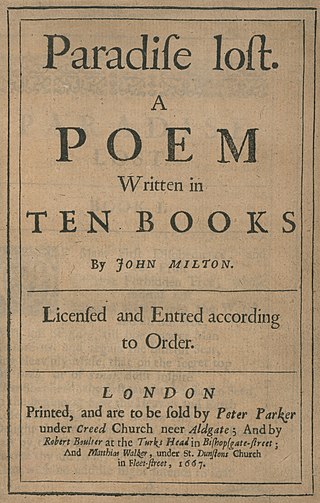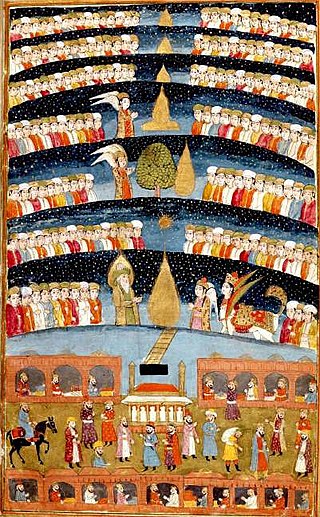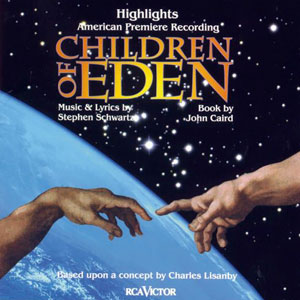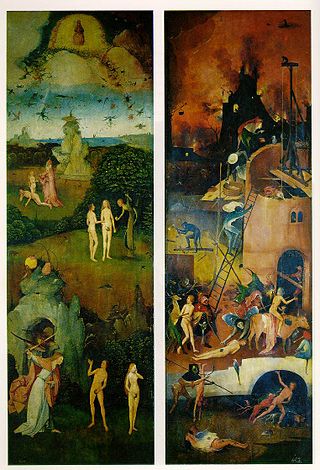Other artistic formats
- The Expulsion from Paradise (1977 film)
The Expulsion from the Garden of Eden and the Expulsion from Paradise refer to the Biblical account of the ejection of Adam and Eve from the Garden of Eden as part of the Fall of man.
"Expulsion from the Garden of Eden" and "Expulsion from Paradise" are the names or subjects of various fine art works:

In Abrahamic religions, the Garden of Eden or Garden of God, also called the Terrestrial Paradise, is the biblical paradise described in Genesis 2–3 and Ezekiel 28 and 31.

Paradise Lost is an epic poem in blank verse by the 17th-century English poet John Milton (1608–1674). The first version, published in 1667, consists of ten books with over ten thousand lines of verse. A second edition followed in 1674, arranged into twelve books with minor revisions throughout. It is considered to be Milton's masterpiece, and it helped solidify his reputation as one of the greatest English poets of all time. The poem concerns the biblical story of the fall of man: the temptation of Adam and Eve by the fallen angel Satan and their expulsion from the Garden of Eden.

In religion, paradise is a place of everlasting happiness, delight, and bliss. Paradisiacal notions are often laden with pastoral imagery, and may be cosmogonical or eschatological or both, often compared with the miseries of human civilization: in paradise there is only peace, prosperity, and happiness. Paradise is a place of contentment, a land of luxury and fulfillment containing ever-lasting bliss. Paradise is often described as a "higher place", the holiest place, in contrast to this world, or underworlds such as Hell.

In Judaism and Christianity, the tree of the knowledge of good and evil is one of two specific trees in the story of the Garden of Eden in Genesis 2–3, along with the tree of life. Alternatively, some scholars have argued that the tree of the knowledge of good and evil is just another name for the tree of life.

In Islam, Jannah is the final abode of the righteous. According to one count, the word appears 147 times in the Qur'an. Belief in the afterlife is one of the six articles of faith in Sunni and Twelver Shi'ism and is a place in which "believers" (Mumin) will enjoy pleasure, while the unbelievers (Kafir) will suffer in Jahannam. Both Jannah and Jahannam are believed to have several levels. In the case of Jannah, the higher levels are more desirable, and in the case of Jahannam, the lower levels have a higher level of punishments. — in Jannah the higher the prestige and pleasure, in Jahannam the severity of the suffering. The afterlife experiences are described as physical, psychic and spiritual.
The Life of Adam and Eve, also known in its Greek version as the Apocalypse of Moses, is a Jewish apocryphal group of writings. It recounts the lives of Adam and Eve from after their expulsion from the Garden of Eden to their deaths. It provides more detail about the Fall of Man, including Eve's version of the story. Satan explains that he rebelled when God commanded him to bow down to Adam. After Adam dies, he and all his descendants are promised a resurrection.

The fall of man, the fall of Adam, or simply the Fall, is a term used in Christianity to describe the transition of the first man and woman from a state of innocent obedience to God to a state of guilty disobedience. The doctrine of the Fall comes from a biblical interpretation of Genesis, chapters 1–3. At first, Adam and Eve lived with God in the Garden of Eden, but the serpent tempted them into eating the fruit from the tree of knowledge of good and evil, which God had forbidden. After doing so, they became ashamed of their nakedness and God expelled them from the Garden to prevent them from eating the fruit of the tree of life and becoming immortal.

Children of Eden is a 1991 musical with music and lyrics by Stephen Schwartz and a book by John Caird. The musical is based on the Book of Genesis, with Act I telling the story of Adam and Eve, and Cain and Abel, while Act II deals with Noah and the flood.

Adam is the name given in Genesis 1–5 to the first human. Adam is the first human-being aware of God, and features as such in various belief systems.

The Expulsion from the Garden of Eden is a fresco by the Italian Early Renaissance artist Masaccio. The fresco is a single scene from the cycle painted around 1425 by Masaccio, Masolino and others on the walls of the Brancacci Chapel in the church of Santa Maria del Carmine in Florence. It depicts the expulsion of Adam and Eve from the garden of Eden, from the biblical Book of Genesis chapter 3, albeit with a few differences from the canonical account.

Adam, in Islamic theology, is believed to have been the first human being on Earth and the first prophet of Islam. Adam's role as the father of the human race is looked upon by Muslims with reverence. Muslims also refer to his wife, Ḥawwāʾ, as the "mother of mankind". Muslims see Adam as the first Muslim, as the Quran states that all the Prophets preached the same faith of Islam.
The Garden of Eden is the Biblical garden where Adam and Eve lived.

The Tragedy of Man is a play written by the Hungarian author Imre Madách. It was first published in 1861. The play is considered to be one of the major works of Hungarian literature and is one of the most often staged Hungarian plays today. Many lines have become common quotations in Hungary. The 1984 film The Annunciation was based on the play, as was the 2011 animated film The Tragedy of Man.

Adam and Eve, according to the creation myth of the Abrahamic religions, were the first man and woman. They are central to the belief that humanity is in essence a single family, with everyone descended from a single pair of original ancestors. They also provide the basis for the doctrines of the fall of man and original sin, which are important beliefs in Christianity, although not held in Judaism or Islam.

Paradise and Hell is the left and right panels of a minor diptych by a follower of Hieronymus Bosch based on The Haywain Triptych. The image is oil on panel and is 135 x 45 cm. It was painted c. 1510 and is now in the Museo del Prado, Madrid. Paradise is depicted darker than in the Haywain, which possibly represents the darkness of original sin.

Adam and Eve is the title of two famous works in different media by Albrecht Dürer, a German artist of the Northern Renaissance: an engraving made in 1504, and a pair of oil-on-panel paintings completed in 1507. The 1504 engraving depicts Adam and Eve in the Garden of Eden, surrounded by several symbolic animals. The engraving transformed how Adam and Eve were popularly depicted in art.

The Garden of Eden with the Fall of Man or The Earthly Paradise with the Fall of Adam and Eve is a painting by Peter Paul Rubens (figures) and Jan Brueghel the Elder. It is housed in the Mauritshuis art museum in The Hague, Netherlands. The painting depicts the moment just before the consumption of forbidden fruit and the fall of man.

Expulsion from the Garden of Eden was painted in 1828 by English-born American painter Thomas Cole. It belongs to the collection of the Museum of Fine Arts, Boston and is on display in their Waleska Evans James Gallery. This landscape painting exemplifies the style of the Hudson River School, which was a group of American landscape painters that Thomas Cole is credited with founding, and is knotted. On the lower left part of the cliff, Cole signed his name as "T Cole".

Expulsion from Paradise or the Expulsion of Adam and Eve is an oil on panel painting by Pontormo, now in the Uffizi in Florence, whose Gabinetto Disegni e Stampe also has a preparatory drawing for it. Its dating is also uncertain and varies between c.1519 and c.1543, but is held to be c.1535 by the Uffizi.

In the biblical story of Adam and Eve, coats of skin were the aprons provided to Adam and Eve by God when they fell from a state of innocent obedience under Him to a state of guilty disobedience.